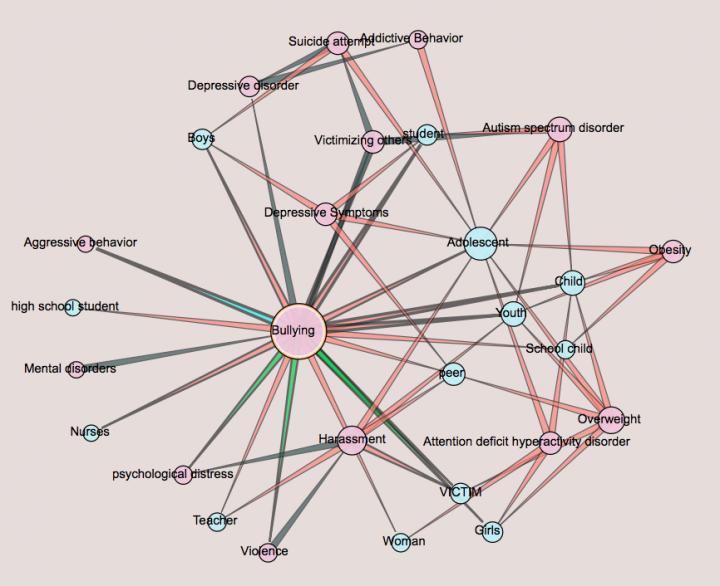
Credit: S. M. Shamimul Hasan/Oak Ridge National Laboratory, U.S. Dept. of Energy
Computing–Broader impacts of bullying
Oak Ridge National Laboratory is using artificial intelligence to analyze data from published medical studies associated with bullying to reveal the potential of broader impacts, such as mental illness or disease. Search results from a computing method known as literature-based discovery could help identify long-term negative consequences of bullying behavior and could inform better-targeted intervention programs. For the study, ORNL’s S. M. Shamimul Hasan applied the algorithm, through a biomedical document retrieval system, to the publicly available medical database Semantic MEDLINE to discover various direct and indirect effects of bullying. “The method uses a three-level approach to detect relationships, for example, from bullying to psychological distress–which is a direct impact–to epilepsy, an indirect consequence,” Hasan said. While the advanced analytical tool makes intelligent inferences, Hasan said for now the process requires a “human in the loop” to validate the connections. He hopes to further enhance the tool’s capabilities. [Contact: Sara Shoemaker, (865) 576-9219; [email protected]]
Image: https:/
Caption: Using artificial intelligence, Oak Ridge National Laboratory analyzed data from published medical studies to reveal the potential of direct and indirect impacts of bullying. Their results could help identify long-term consequences and could inform better-targeted intervention programs. Credit: S. M. Shamimul Hasan/Oak Ridge National Laboratory, U.S. Dept. of Energy
Grid–Wrap-around sensors
Scientists at Oak Ridge National Laboratory have developed a low-cost, printed, flexible sensor that can wrap around power cables to precisely monitor electrical loads from household appliances to support grid operations. Using an inkjet printer, researchers deposited wires on a flexible plastic substrate, then wove in a magnetic strip to channel the flux produced by an electric current, making the sensor suitable to install in tight spaces. When tested on conductors in the lab and on a building HVAC unit, the sensor measured responses of up to 90 amps of electrical current, and is expected to exceed 500 amps in larger applications. “These inexpensive sensors provide crucial, real-time usage data needed to monitor and control devices such as smart HVAC and water heaters for better power grid efficiency and resilience,” said ORNL’s Pooran Joshi. The team is currently testing new materials, electronics and packaging to increase the sensor’s range and applications while keeping costs low. [Contact: Stephanie Seay, [email protected]; (865) 576-9894]
Image: https:/
Caption: ORNL scientists have created a low-cost, compact, printed sensor that can collect and transmit data on electrical appliances for better load monitoring. Credit: Genevieve Martin/Oak Ridge National Laboratory, U.S. Dept. of Energy
Nuclear–Remote-controlled reactors
Oak Ridge National Laboratory scientists are evaluating paths for licensing remotely operated microreactors, which could provide clean energy sources to hard-to-reach communities, such as isolated areas in Alaska. “Current regulatory guidance was written when remote operations of nuclear reactors were not possible, so this is a new frontier,” said ORNL’s Randy Belles. The flexibility of microreactors–which could power thousands of homes for a decade without refueling and be easily transported due to their compact size–could allow operators to autonomously control them using advanced computing systems. This would help limit onsite staffing, and increase economic viability. “Our team’s evaluations aim to address several licensing questions that come with remote operations, such as handling cybersecurity, staffing and manipulations of the controls,” Belles said. The next step is advising Nuclear Regulatory Committee staff about the guidance needed to make deployment possible. [Contact: Jason Ellis, (865) 241-5819; [email protected]]
Image: https:/
Caption: Oak Ridge National Laboratory scientists are evaluating current regulatory guidance to understand the potential challenges in licensing remotely operated microreactors. Microreactors could offer unique mobility and flexibility–opening the possibility for nuclear energy to reach isolated areas. Credit: Adam Malin/Oak Ridge National Laboratory, U.S. Dept. of Energy
Clean Water–Better separations
A team of scientists led by Oak Ridge National Laboratory used carbon nanotubes to improve a desalination process that attracts and removes ionic compounds such as salt from water using charged electrodes. Carbon nanotubes have superior ability to conduct electricity. When applied to the desalination process known as flow-electrode capacitive deionization, the nanotubes boosted electroconductivity by 13.2 times and increased the desalination rate by 34 percent, with only a slight increase in solution viscosity. The result was salt water removal efficiency of 93.6 percent, as detailed in ACS Sustainable Chemistry & Engineering. “The process is particularly good at treating industrial wastewater and could help meet the global challenge of fresh water availability,” said ORNL’s Costas Tsouris. He added that exploring the use of carbon fiber in the process could result in similar improvements at a lower cost. [Contact: Stephanie Seay, [email protected], 865-576-9894]
Image: https:/
Caption: Scientists used carbon nanotubes that enhanced conductivity and sped up a salt water removal process known as flow-electrode capacitive deionization. Reprinted with permission from Kexin Tang, et al., “Enhanced Water Desalination by Increasing the Electroconductivity of Carbon Powders for High-Performance Flow-Electrode Capacitive Deionization.” ACS Sustainable Chemistry & Engineering. Copyright 2019. American Chemical Society.
###
Media Contact
Sara Shoemaker
[email protected]
Original Source
https:/




